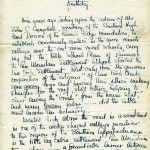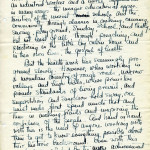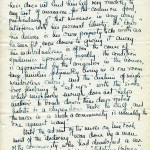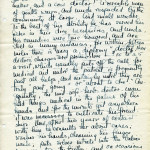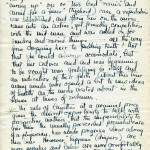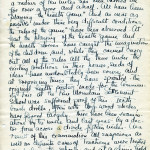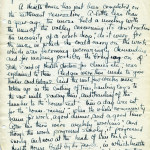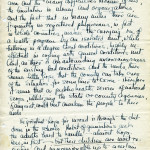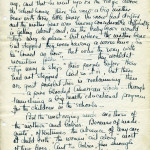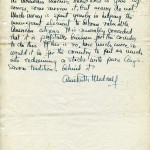Pine Mountain Settlement School
Series 09: BIOGRAPHY- Staff
Series 14: MEDICAL
Anne Ruth Medcalf, Nurse, 1921-1924
Line Fork Settlement Report n.d.
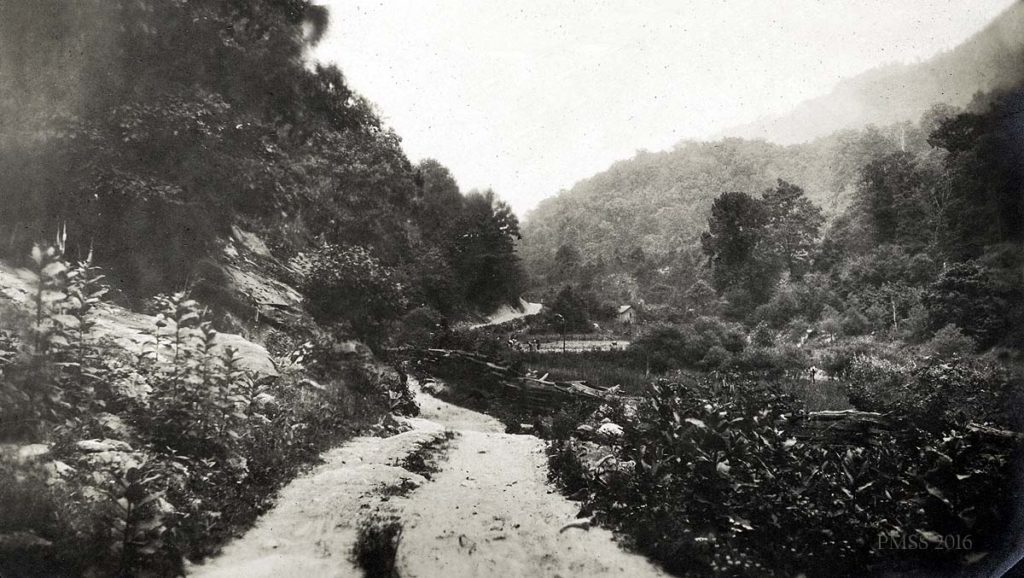
“Near Line Fork Settlement, June 21,” 1923. BC_3566. Kathrine True Album, modified. [true_040_mod.jpg]
TAGS: Anne Ruth Medcalf report, nurses, Line Fork Settlement, industrial workers, public health services, community, individualism, epidemics, mid-man, typhoid, layettes, trachoma, tonsil operations, health posters, toothbrush drills, Health House, clinics, health educational programs
ANNE RUTH MEDCALF Line Fork Settlement Report, n.d.
PMSS Nurse, Line Fork Settlement, Gilley, Letcher Co., KY, 1921-1924
TRANSCRIPTION (c. 1922 ?) to Miss Pettit
Three years ago, acting upon the advice of Mr. John C. Campbell, secretary of the Southern Highland Division of the Russell Sage Foundation to establish community centers in the more remote valleys near the one-room rural schools, carrying out the Folk School Plan of Denmark, the Pine Mountain Settlement School started the Line Fork Settlement. But only thru the generous cooperation of the “citizens” of Line Fork creek — some giving logs and hewing the logs, others making shingles for the roof, still others helping to clear away the “bresh” from the “house seat,” and many giving labor — did the settlement become an actuality.
Located high above the road in a woodland in one of the wedge-shaped valleys peculiar to this region of the Southern Appalachians, is the little log cabin settlement. Pine Mountain towers above — a formidable barrier between it and the big outside world. Never the less, here lives a bit of “the outside”: two “fotched-on” teachers, an industrial worker and a nurse supplement the meager educational opportunities of the nearest schools and the community through classes in cooking, canning, sewing, playground, Sunday School, and lastly but not least of all, through preaching and practicing in the little log cabin house and in their own lives the gospel of health.
But the health work has seemingly progressed slowly. However, when working in a mountain country of rough roads, narrow valleys and high hills where primitive pioneer standards of living prevail, and superstition and suspicion hold sway, one must needs first spend much [time to undo] that and time in making friends and inspiring the confidence of the people. And, hand-in-hand with this is the need of anyone working with them to get to know everything possible about their historic background. Even with this much accomplished by the nurse, achievement along public health lines is strenuous up-hill work.
The Southern Highlander, individualist that he is, does not lend himself very readily to any sort of measures for the common good, particularly if that measure in any way interferes with his personal liberty. He “‘lows” his disease is his own property to do with as he sees fit even down to givin’ it away. The individualism is often the cause of epidemics spreading rapidly. The condition is aggravated by the congestion in the houses, large families, frequently living in a one-room, windowless cabin; and the custom of neighbors flocking to “set up” with the sick, while neighborly enough, does not help matters to break down these deep-rooted habits — is a stupendous task in itself and the nurse in such a community is usually the “one against many.”
Until the advent of the nurse on Line Fork, most of the “doctoring” was done by a man of the community, who developed a certain amount of skill in “fetching babies,” mixing teas of herbs and roots, and the working of charms. All of which is a side issue, for he is a farmer, a well-digger, a chair maker, and a cow doctor! A versatile man of gentle ways, and much respected by the community at large. And small wonder. To the best of his ability, he has served his folks in their dire necessities and needs. His remedies were time-honored, and are still in many instances, for within fifteen miles there is “nary a diplomy” doctor. Then doctor’s charges are prohibitive — $15 to $25 a visit, which usually puts off the call for medical aid until the patient is frequently past all help, and certainly until they are truly “past going” or “about to die.” Consequently, the mid-wife-herb-doctor-man held things medical in the palms of his hands, and for the nurse to get anywhere it was necessary to cultivate his friendship. Now after two years of contact with him he consults her about cases; washes his hands, cleaning his fingernails; puts silver nitrate into the babies eyes; registers the births; and on occasions even condescends to wear a gown over his blue denim over-alls!
In the beginning the people could not make out just what constituted a nurse, but after “curing-up” one or two bad “visiees” and caring for a “fever” (typhoid) case, a reputation was established, and from then on the nurse came into an active, yet friendly, competition with the mid-man and was called on for sundry and varied things — all the way from cropping hair to pulling teeth! Not that she could always accommodate, but that her advice and aid was beginning to be sought was gratifying in itself and an indicator of their faith. About this time many minds were opened a bit to new ideas of health as the nurse visited about in the houses at times of sickness.
The sale of layettes at a nominal price gives the desired opportunity to talk with prospective mothers, but the impossibility to give them the usually prescribed prenatal care of a physician, has made progress slow along these lines. However, “hippens” (diapers) are more popular, and babies are more comfortably dressed, because of this sale, than they were two years ago.
Health work in the one-room rural schools within a radius of ten miles has been carried on for over a year and a half. All have been “playing the health game” and, as near as possible under these very difficult conditions, the “rules of the game” have been observed. At best the playing of the health game and the health stories have caught the imagination of the children, and, while they cannot carry out all of the rules all the time under the existing conditions in their houses, seeds of ideas have undoubtedly been sown, and at surprising times they have sprouted — the original health posters made for the Community Fair at the Pine Mountain Settlement School was sufficient proof of this. Toothbrush drills, often with dog-wood sticks, have figured largely. There have been examinations by the nurse and last year by a doctor from across a divide — fifteen miles. As a result of this examination all suspcious [sic], as well as definite, cases of trachoma were treated regularly in the schools; and at a clinic held at Pine Mountain Settlement School, 25% of the school children needing tonsil operations were operated upon.
A Health House has just been completed on the settlement reservation. A little less than a year ago, the nurse held a meeting with the men of the valley concerning its construction. The necessity of a “work shop,” as it were, for the nurse in which she could carry on the work which was becoming increasingly demanding and for making possible the “branging-on” of State Board of Health doctors for clinics, etc., was explained to them. Pledges were then made to give timber and labour. And, the next few weeks were taken up in the cutting of trees, hauling logs to the saw mill, sawing them, and then hauling of the lumber to the “house seat”. Then a day was set for the “house-raisin’,” when the whole community came for work, a good dinner, and a good time. After this there were weekly “workins’,” and though the work progressed slowly, it progressed surely, and now at the head of Line Fork is a Health House, built by the people, in which health activities of various sorts may be held for the promotion of their health.
The extremely rural situation in the Appalachian area and the many difficulties because of this, — the limitation in money and organization, and the fact that in many miles there are frequently no registered physicians, in fact in whole counties, makes the carrying on of a health program by an isolated unit, while bettering in a degree local conditions, highly ineffectual in coping with general conditions met. And, as there is an astounding unconsciousness of the existing bad conditions and the needs, there seems little hope that the country can take care of the situation for some time to come. Therefore, it seems that a public health service of national scope, utilizing the state or county agencies, if any exist, could best awaken the people to their needs.
The greatest hope for inroad is through the children in the schools. Habit of generations make the adults hard to handle — almost hopeless, in fact — but their children are most receptive and impressionable up to certain age. The attitude of mind can best be described by a story one of the more enlightened native school teachers tells. He dreamed it was snowing, and that he went up on the ridge above the school-house. There he saw a big mother bear was having considerable difficulty in getting about, and, as the baby bear would “step nary a place” but where the mother bear had stepped, they were having a worse time. So he “‘lowed as how that was the way with mountain folks” — They wouldn’t “step ary a step” their people before them had not stepped. And, so it is, but there are great possibilities in reclaiming them — a pure-blooded American stock — through launching a big health educational program for the children in the schools.
But the most crying need are those of the mothers and babies. Because of inadequate, often times the absence of any care at child-birth, the women “ail along” most of their lives. And the babies, fine enough specimens at birth, become sickly, puny, young ones after submitting to the only care the mountain mothers know how to give. Of course, some survive it, but many do not. Much money is spent yearly in helping the immigrant element to become valuable American citizens. It is generally conceded that it is profitable business for the country to do this. If this is so, how much more so would it be for the country to put as much into redeeming a stock with pure Anglo Saxon traditions behind it?
GALLERY: ANNE RUTH MEDCALF Line Fork Settlement n.d.
(probably 1922 ?) to Miss Pettit
- [lf_medcalf_001.jpg]
- [lf_medcalf_002.jpg]
- [lf_medcalf_003.jpg]
- [lf_medcalf_004.jpg]
- [lf_medcalf_005.jpg]
- [lf_medcalf_006.jpg]
- [lf_medcalf_007.jpg]
- [lf_medcalf_008.jpg]
- [lf_medcalf_009.jpg]
- [lf_medcalf_010.jpg]
See Also:
ANNE RUTH MEDCALF 1924 “In the Line Fork Country.” American Child Health Magazine, December 1924
ANNE RUTH MEDCALF Correspondence I 1921-1922
ANNE RUTH MEDCALF Correspondence II 1923-1924
ANNE RUTH MEDCALF Report to Miss Pettit 11 Feb 1922
ANNE RUTH MEDCALF Staff – Biography
LINE FORK Settlement
MEDICAL Guide
Return To:
LINE FORK SETTLEMENT WORKERS Reports Publications Guide 1921-1941

